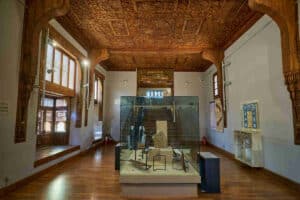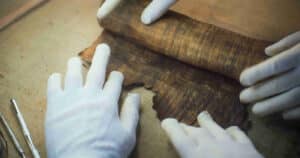The ancient Egyptian civilization would hardly have achieved its success and expansion without one of its key discoveries: papyrus. This plant-based medium boosted writing and, with it, better administration at all levels of society, as well as other forms of religious expression crucial for its inhabitants. In this post, we give you some curiosities about Ancient Egyptian papyri, which you can admire in person if you visit some of the museums that exhibit specimens.
What Papyrus Is and How It Was Made
Papyrus is a writing medium that uses fibers from the homonymous plant (Cyperus papyrus, by its botanical name), which was cultivated in the fertile Nile Valley. A very sophisticated weave was produced, which was polished with pumice stone. The oldest specimens show that by 2500 BC, papyri were already being used to write a wide variety of content on them.
It was the most convenient and versatile alternative to the clay tablets used in Mesopotamia. They predated parchments (made from animal skin) used in the Greco-Roman world (Asia Minor) and with which it also competed. In fact, the Egyptian Library of Alexandria was based on papyrus, while its rival, that of Pergamum, used parchment. By the 2nd century AD, paper emerged in China, gradually displacing both.
What Was Written on Them
Initially (Old and Middle Kingdom), papyrus was used to contain administrative and everyday texts, for which a more simplified version of hieroglyphic writing was created: hieratic. In contrast, hieroglyphs, more elaborate and beautiful, were mainly reserved for monumental places, such as sarcophagi or temple walls.
However, during the New Kingdom (from the 18th Dynasty, around 1500 BC) a luxurious and exclusive version of scrolls began to develop: the Books of the Dead. These papyri, which when unrolled could reach a considerable length, were compositions that combined writing and drawing to protect and give strength to the deceased in their journey to the Afterlife. Therefore, they always accompanied the mummy of their owner in their tomb, and reached truly remarkable levels of perfection. Professional and specialized scribes devoted themselves to this activity, developing it until the Late Period and even the Hellenistic period.
Great Examples of Papyri in Ancient Egypt
Unfortunately, being a plant fiber, the vast majority of Ancient Egyptian papyri have not survived to the present day. Only a few that, due to special circumstances, have withstood the test of time are preserved. Given their beauty, suggestive power, and even documentary value, many of the surviving papyri fell into the hands of foreign collectors, so they are exhibited in museums outside Egypt.
However, other truly spectacular specimens are preserved on Egyptian soil. A good example of this is the Book of the Dead of Ahmose, discovered in 2023 in Saqqara, restored and exhibited in the Egyptian Museum in Cairo. Its length exceeds 15 meters and its extraordinary state of preservation facilitates its study and understanding.
Not as well preserved is the Wadi Al Jarf, found in 2013 in an ancient Ancient Egyptian port on the Red Sea. And therein lies its value: it is one of the oldest that have been found and its content speaks of the construction of the Pyramids of Giza. It is also kept at the Egyptian Museum in Cairo.
On the other hand, among the most famous papyri distributed around the world are the Papyrus of Ani (British Museum), which is a Book of the Dead of sublime beauty, the medical papyri (various European museums, mainly) in the form of medical treatises, or the Turin Royal Canon (in the Egyptian museum of that city), key to establishing an ordered account of the history of that civilization.




